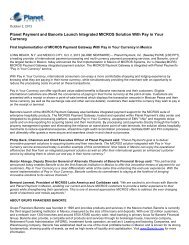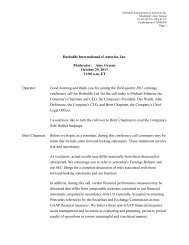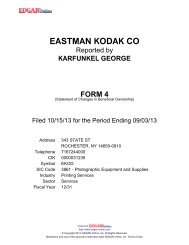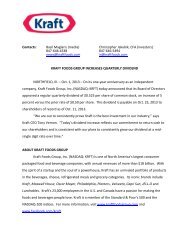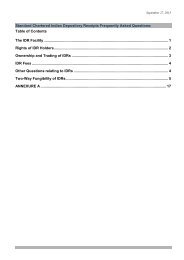Hypercom Corporation Annual Report - CiteSeer
Hypercom Corporation Annual Report - CiteSeer
Hypercom Corporation Annual Report - CiteSeer
You also want an ePaper? Increase the reach of your titles
YUMPU automatically turns print PDFs into web optimized ePapers that Google loves.
On April 1, 2008, we acquired all of the outstanding shares of Thales e-Transactions SA, Thales e-Transactions GmbH, Thales e-<br />
Transactions Ltd, and Thales e-Transactions España, (collectively, “Thales e-Transactions” or “TeT”). Thales e-Transactions was a<br />
leading provider of secure card payment solutions in some of Europe’s largest markets, including France, Germany, Spain and the<br />
United Kingdom. With the acquisition, <strong>Hypercom</strong> has become one of the largest providers of electronic payment solutions and<br />
services in Western Europe, solidifying our position as the third largest provider globally, and expanded our team of industry experts<br />
that will lead our operations going forward.<br />
With worldwide headquarters in Scottsdale, Arizona, we market our products in more than 100 countries through a global<br />
network of sales, service and development offices. Our main regional sales headquarters are located in the U.S., Brazil, Mexico,<br />
France, Germany, and the Philippines.<br />
Electronic Payments Industry<br />
Over the past several decades, consumers worldwide have increasingly utilized card-based payment methods, such as credit,<br />
debit, and gift cards, to replace checks and cash. Card-based payments require the use of a point of sale (“POS”) terminal capable of<br />
reading a cardholder’s account information from the card’s magnetic stripe or chip and combining this information with the<br />
transaction information. The POS terminal electronically captures and securely transmits this information over a communications<br />
network to an authorized computer data center and then displays the returned approval or denial response.<br />
The structure of the electronic payments industry is best described by examining the entities involved and their relationship to one<br />
another. Card associations, like Visa and MasterCard, which license their “brand” to card issuers, such as banks, operate high volume<br />
communications networks connecting card issuers with transaction processors. Card associations also define the standards that POS<br />
terminals must meet to be certified for use in their respective networks. Transaction acquirers and their agents sign up merchants,<br />
install POS terminal equipment, capture the transaction data, and route it through the credit or debit card network to obtain transaction<br />
approval. Payment processors charge an interchange fee to authorize the customers’ transactions, providing a tally of these<br />
transactions to merchants, and transfer funds to merchants to cover card purchases. Card issuers provide consumers with the payment<br />
card and settle their accounts. Equipment providers make the POS terminal hardware and software and, in our case, also network<br />
equipment upon which high-performance and secure payment processing networks rely. Transaction services providers facilitate the<br />
delivery of the transaction data between merchants and payment processors. This structure may vary in each geographic region or<br />
country where multiple functions may be performed by a single entity such as a bank.<br />
Card associations, bank card issuers, transaction acquirers and payment processors are differentiating their offerings, in part, by<br />
offering value-added applications and incorporating innovative acceptance technologies including contactless, biometrics and flexible<br />
connectivity options like wired and wireless internet protocol technologies. As a result, electronic payment systems that can run<br />
multiple value-added applications and incorporate emerging technologies are becoming increasingly important in today’s market.<br />
Payment systems require an exceptionally high level of reliability and security, as even an apparently small system failure or a<br />
security breach can have significant consequences. The electronic payments industry operates in a secure environment of dedicated<br />
systems, applications, specialized hardware products and access networks. The industry will continue to evolve as the demands of the<br />
market and the rules that govern its standards and security change rapidly.<br />
During 2009 and continuing into 2010, there has been continuing focus on the security of the payment system. Several large<br />
breaches of transaction processors’ and retailers’ systems around the world have resulted in increasing levels of fraud. As a result,<br />
there has been an increased focus on the security standards and audit requirements followed by the industry. In order to promote a<br />
common understanding of published security requirements and develop security best practice guides, <strong>Hypercom</strong>, Ingenico SA<br />
(“Ingenico) and VeriFone Holdings, Inc. (“VeriFone”) formed the Secure POS Vendors Alliance (“SPVA”) in April 2009.<br />
Under current industry rules, retailers around the world have been forced to invest considerably in security audits in order to<br />
demonstrate compliance with the Payment Card Industry (“PCI”) security requirements. These audit expenses can extend into the<br />
millions of dollars yet, as has been demonstrated by several breaches, does not guarantee immunity from security breaches. As a<br />
result, in 2009 we began to see some major retailers outsource to third parties their complete payment systems, from card swipe or<br />
insertion through transaction settlement and reporting, in order to remove all payment card data from their systems and significantly<br />
reduce or eliminate their PCI audit expense. <strong>Hypercom</strong> has been successful in providing outsourced payment solutions for several<br />
large retailers in France, and our expectation is that this is a trend that will continue to grow across all major card payment markets<br />
and geographies, which we believe will provide us with future growth opportunities.<br />
- 3 -




